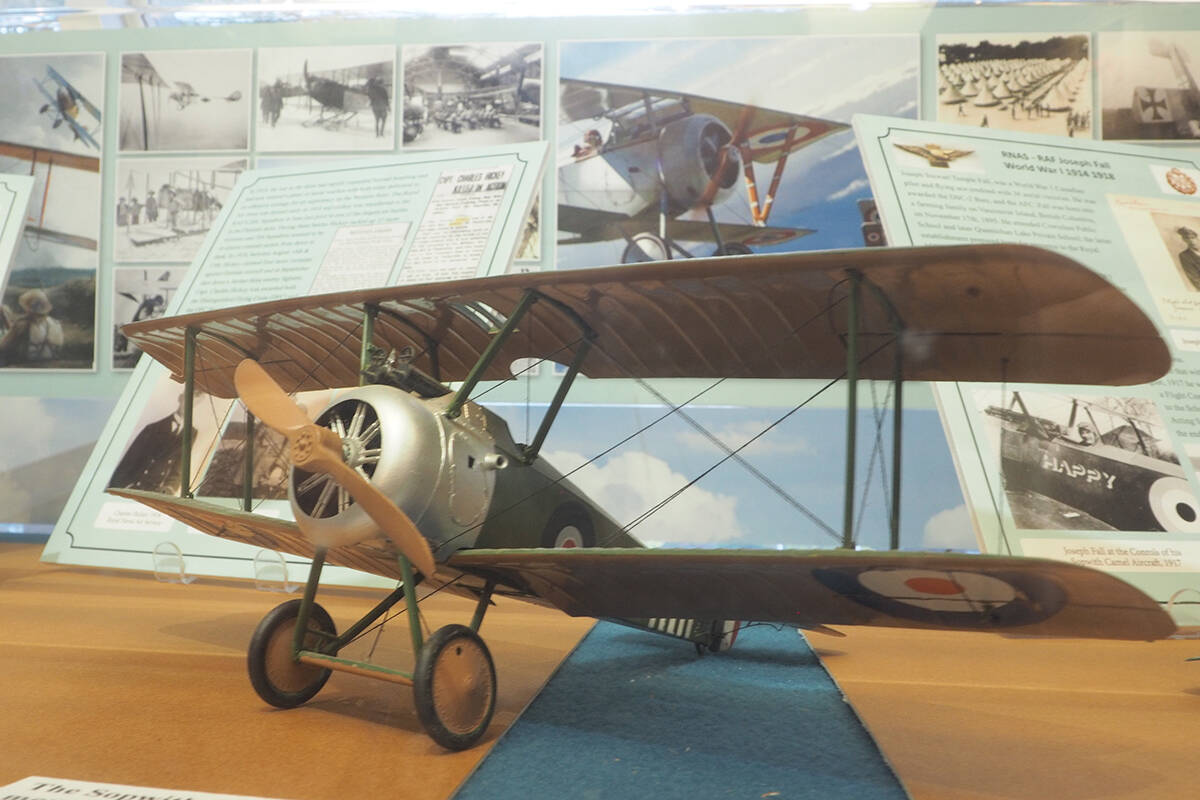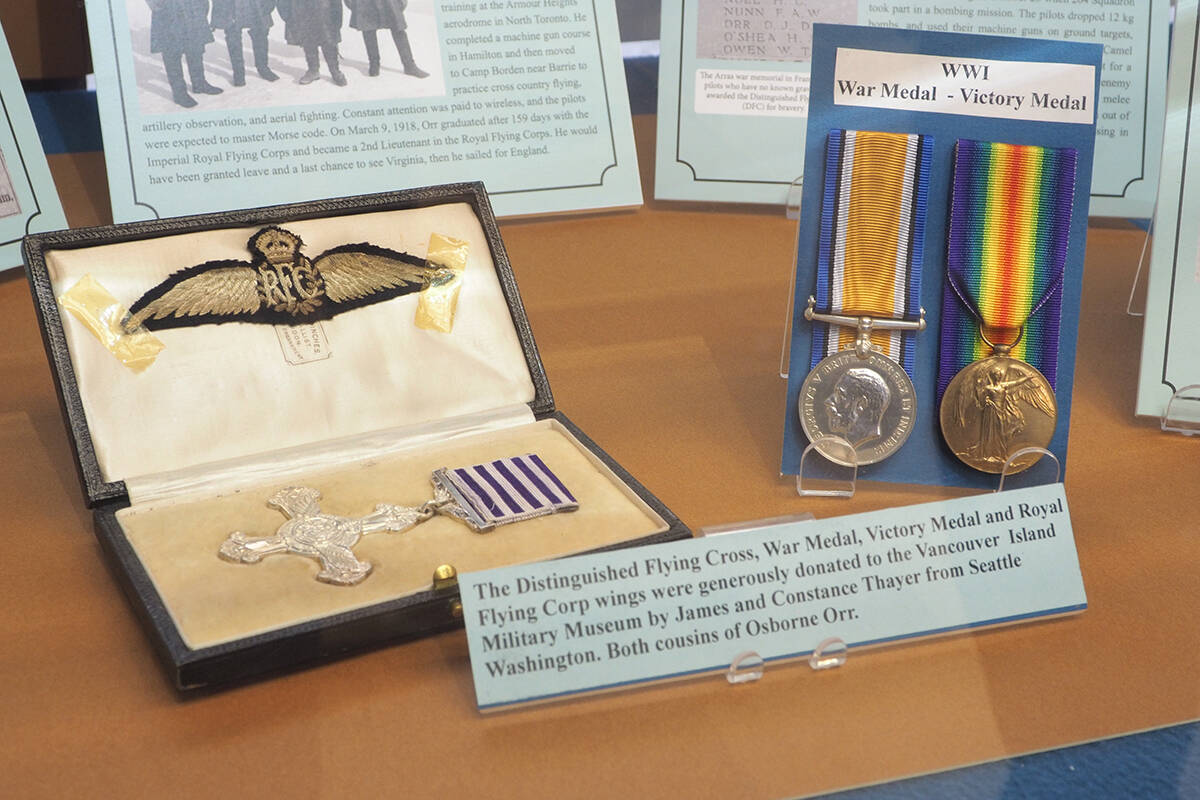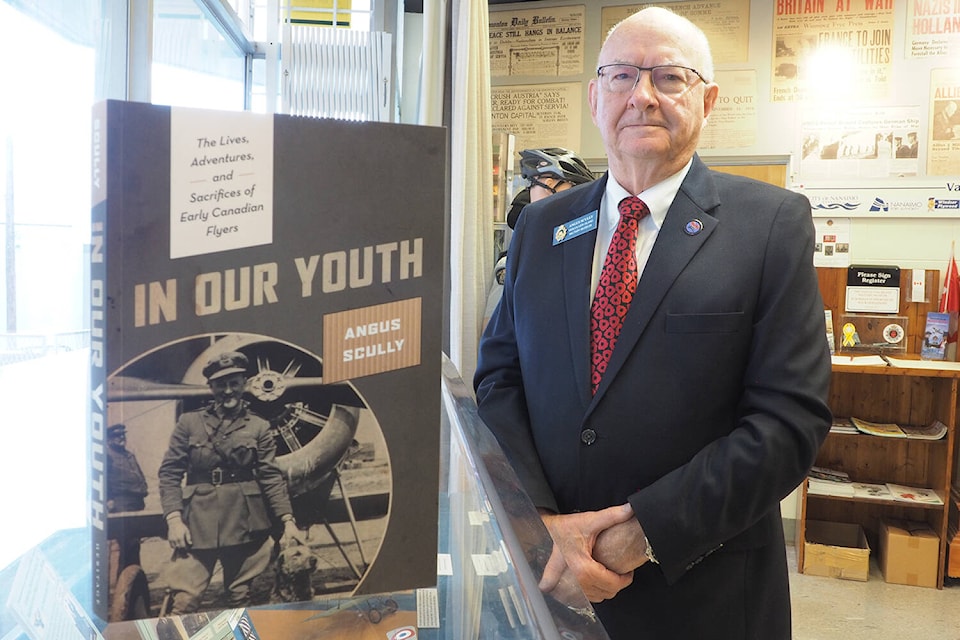The Vancouver Island Military Museum has a new display honouring First World War aces whose roots are from the Nanaimo region.
The research into the pilots – who combined for many air victories – and their aircraft for the display was carried out by Brian McFadden, Vancouver Island Military Museum vice-president, and Angus Scully, writer, editor, historian, educator and author of 15 Canadian history textbooks for elementary and high schools. Scully is also editor of the VIMM’s newsletter and is on the museum’s board of directors.
“The most famous of them was Raymond Collishaw,” Scully said. “He shot down 60 aircraft. He’s on the list of top aces of the war. He’s a real Canadian hero … Then there’s Joseph Fall. He was from Cobble Hill … and he is a well-known ace. He survived the war, as did Collishaw. Next, I came across Charlie Hickey. He was from Nanaimo and Parksville. His family is from Parksville and Charlie Hickey went to Nanaimo High School.”
READ ALSO: Island flying ace shot down 21 foes in First World War
Lieut. Charles Robert Reeves Hickey joined the cavalry at the start of the war, Scully said, but transferred to the Royal Air Force. He is credited with 21 victories and was awarded the Distinguished Flying Cross and Distinguished Flying Cross Bar. He was killed in action Oct. 3, 1918, mere weeks before the end of the war, and is buried in Belgium.
Lieut. Osborne John Orr, credited with five aerial victories before he was also shot down and killed, was born in Nanaimo in 1895. His origins and connection to Nanaimo came to light in 2020.
READ ALSO: Nanaimo’s other First World War ace remembered
Joseph Stewart Temple Fall is credited with 36 air victories while serving with the Royal Navy Air Service and was awarded the Distinguished Flying Cross three times and the Air Force Cross. He retired from the Royal Air Force as a group captain in 1945.
“So here we have, if you start in Parksville where Hickey was born, Nanaimo with Collishaw and Orr, and then down the road a bit, you come to Fall in Cobble Hill,” Scully said.
Scully’s research also revealed another wartime pilot, John Rowan, from Gabriola Island.
“He was not an ace. He never got a chance,” Scully said. “He was killed in Fort Worth, Texas, in a flying accident.”
Some Canadian pilots were sent to Texas for training in the winter because it was not known if they would be able to fly in harsh winter conditions in Ontario.
“They kept some in southern Ontario to see how it would go,” Scully said. “As it turned out, the southern Ontario pilot training program was just as effective in the winter as was the training in Texas, so this young guy from Gabriola Island, who went to Nanaimo High School, became a teacher in Powell River and then he joined the [Canadian] Royal Flying Corps … He joined up, went with the Royal Flying Corps for training in Texas and was killed in a flying accident. His parents had his body returned from Texas and he’s buried here in Nanaimo Cemetery.”
Scully said given the small population of the area at the time and aviation being a new technology, it’s notable that five aviators – four of them aces – came from the mid Island.
Scully’s research into the pilots and their exploits during and after the war led him to write In Our Youth: The Lives, Adventures and Sacrifices of Early Canadian Flyers, a book launched at an invitation-only event at the Vancouver Island Military Museum on Nov. 3. He and his family members, as well as family of the pilots, gathered for a small ceremony and viewed the museum’s brand-new display which contains examples of the pilots’ medals and information about their military service and the aircraft they flew. Also on display are highly detailed models of the aircraft they flew, some built by museum staff, such as Pat Murphy.
“He spent a lot of time trying to get that thing perfected,” Scully said, pointing to a 1:72 scale model of a Curtiss JN ‘Jenny’ training biplane of the era. “That’s painted to look exactly like the plane Osborne Orr trained in in Toronto. When the rest of them went to Texas he stayed behind and trained in the winter … It was one of the coldest winters on record in Toronto.”
Photographs in the display depict winter scenes of Orr and other airmen bundled up against the cold. At the time, cockpits were open to the elements with only a windshield to deflect the propeller wash of freezing cold air. Aircrew were lucky if they could glean some heat blowing back from their aircraft’s motor. There was no oxygen supply, radio or other accessories and comforts developed for aircraft following the war. The planes were also fragile and could break apart when their wing structures were overstressed. It was a time of rapid development of the technology driven by the need to outperform adversaries facing the same challenges.
“It was dangerous. It was exciting. It was the latest high tech. I use that term in the book and I’ve had people react to the ‘high tech’ and I’ve said, no, this was 1914-18. This is high tech … They were still experimenting with planes,” Scully said, gesturing toward one of the models. “This one here that Collishaw flew. It was taken out of service because the wings kept falling off … They were still coming to grips with the stresses and what was going on in flight.”
Some aircraft were particularly dangerous to fly. The design characteristics that made the Sopwith Camel a highly agile and successful fighter during the war also made the machine’s handling temperamental and at times treacherous.
“There were so many pilots, cadets dying that it became a question in Parliament. The Toronto Star created a big stink, ‘What are you doing killing our boys?’” Scully said. “Of the 400 men who died flying them in combat, 380 more died learning to fly them. So dangerous. Here’s this kid, joins up, and he’s killed in a training accident.”
The Vancouver Island Military Museum will be open to the public follow Remembrance Day services Nov. 11. For more information about Scully and his book, visit www.angusscully.com.
editor@nanaimobulletin.com
Like us on Facebook and follow us on Twitter


